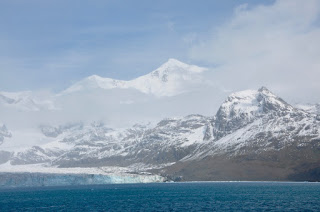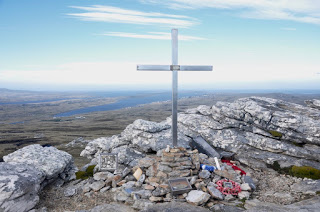This part 5 in an ongoing series I’m writing about my recent travels to the Falkland Islands and South Georgia with Lindblad Expeditions earlier this year. If you haven’t read the first three parts, and would like to, you can find them here, here, here, and here.
In our last installment of this series I wrote about my experiences hiking on South Georgia and following in the footsteps of Ernest Shackleton, who once trekked across the rugged interior of that island in a desperate search to find help. I also talked about my visit to Grytviken, the only village there that still has a few inhabitants. After departing that place, we continued to explore more of the coastline, including approaching calving glaciers in zodiacs. But, the weather forecast took a turn for the worse, and conditions began to deteriorate rapidly. It was clear the austral winter would be arriving soon, and it was time for us to turn for home.
On our third day in the waters off South Georgia the winds began to pick up and the waves began to grow. The already chilly temperature took a plunge and the skies turned menacing. It was clear that there was a change coming, so our crew decided it might be time to bug out early. We were scheduled to stay another full day, but if we did, we probably wouldn’t be able to go ashore anyway. Storms were definitely closing in, and our window of opportunity was closing rapidly, so we turned the ship back north and started once again for the Falkland Islands.
Before we left however, we did go ashore one more time and went on another short hike up to a mountain lake. The weather conditions had already started to change, and as we walked we were battered by winds of up to 45 knots (51 mph/83 km/h), which pushed us too and fro as we trudged up to a high ridge. Snow and rain began to fall, with tiny ice pellets blasting our face too. Needless to say, it was hardly a day fit to be outside, and yet those of us who went on that hike still wanted to see as much of South Georgia as we could before we left it behind.
The tumultuous winds swirled around us furiously, clouding our view of the island with spindrift. But, on occasion, you could still spot the high peaks towering overhead. Rough and jagged, these mountains cut a dramatic backdrop to our walk, which was turning out to be a real adventure. In fact, when we finally decided it was time to give up on our hike and return to the ship, we found our way down wasn’t easy. Scrambling over rocks and cliffs wasn’t in the itinerary for most of my companions, who generally were looking for a relaxing stroll rather than an adrenaline-inducing challenge. Eventually we descend along the bed of a stream, with loose rocks and running water under our feet. It wasn’t the most comfortable and easy way to get down, but it was better than the alternatives and allowed us to arrive back at the beach safe and sound.
From there, we returned to the National Geographic Explorer, and began the voyage away from South Georgia. It would be another two days across the Drake Passage to return to the Falklands, and this time we wouldn’t have such an easy crossing. The waters in the Drake were more turbulent on the return trip, making it a challenge once again just to stay upright while walking about the ship. Those who had gotten over their previous bouts of seasickness found their stomachs a bit queasy once again as the ship listed about in the rollicking waters. I was told that what we experienced wasn’t close to how rough the passage can actually be, so even seeing it in this state made me appreciate how much worse it could have been. Thankfully, I don’t suffer from seasickness however, or the experience could have been much worse.
Eventually we did cross the Drake however and arrived back in the Falklands. Our first stop this time out however was going to be a bit less wild. We dropped anchor at Port Stanley, the capital city of the islands, and home to about 2500 people. Considering only about 3500 people live in the Falklands, you can appreciate that it is a bustling metropolis compared to the rest of the area.
Stanley is home to some important monuments, including the Christ Church Cathedral, several monuments to the 1982 Falklands War with Argentina, and the famous Whalebone Arch. The town also has several restaurants and pubs, which were a welcome site after dining aboard the Explorer for the better part of two weeks.
Wandering around Stanley is a lot of fun, and a bit eye-opening. There are a surprising number of landmarks to be seen there, including a shipwreck or two in the harbor, an interesting museum, and a bust of former British Prime Minister Margaret Thatcher. But, it was also clear that the residents of the town had not yet forgiven the Argentines for invading the Falklands back in in 1982. There were signs and bumper stickers throughout out the town that boasted of British nationalism and condemning Argentina for its acts of aggression. More than 35 years may have passed since the war, but the wounds have yet to heal.
After lunch, a few of us joined a local guide and went for a hike up into the highlands that surround Port Stanley. Some of the heaviest fighting and most important battles of the war took place in that area, and as we walked, the locals told us about how things unfolded. Even now, passing through those fields, remnants of the fighting remain. We not only found a few rounds of unspent ammunition, but we came across abandoned vehicles and other items that were left behind when the Argentines departed. Fox holes and bomb craters also mark the landscape, and although they are overgrown with weeds, it is clear what they once were.
The most sobering scene was found on top of a high cliff that overlooks Stanley and the sea. There, we came across a monument dedicated to the British soldiers that fell while liberating the Falklands. There were messages to these soldiers from their loved ones, and various tokens left behind to remember them. It was a quiet, solemn place that still means a lot to the Falklanders who appreciate that their countrymen came to their defense and helped return the islands to British control.
After our day in Stanley, we had several more days to explore other parts of the Falklands before we would cross back over to the South American continent and begin our journey home. We spent those days visiting more of the islands, stopping by places like Kepple Island and Saunders Plain. These places were once again home to large numbers of albatross and penguins, with the rock hopper species making an appearance at last.
Our shore excursions took us on hikes to remote areas where few people ever visit, including one destination that has only been visited by travelers twice in the past 20+ years. This is a credit to what the good folks and Lindblad can pull off for their passengers, as on more than one occasion they were able to negotiate an opportunity for us to spend time in places that are often out of reach for the common traveler. This mean we had those places completely to ourselves, bringing the sense of solace and isolation that are a major part of why we love adventure travel.
After the mountainous landscapes of South Georgia, the more sprawling, open spaces of the Falklands seemed like a sharp contrast. But, the islands are beautiful in their own right and is is hard not to be captivated by their wildness. It is equally hard not to be impressed with the people who live there and manage to eke out a life. Everyone that we encountered loved what they did and where they lived however, which is a testament to how special the place truly is.
In a flash, our last few days in the Falklands were over, and it was time to think about the journey home. We set sail across the southern Atlantic and returned to Ushuaia in Argentina, where our journey began. But before we boarded a plane back to Buenos Aires, and then home, we did have a bit of time to wander around the most southerly city in the world. I found it to be a lovely spot that mixed both South American and European culture nicely. Ushuaia is a ski destination throughout the winter, and the architecture found there reminded me of the chalets that are common in the Alps. Gear shops lined the streets, allowing travelers to shop for those last minute outdoor products they need, while small restaurants and cafes were common as well. I got the sense that I could easily spend another few days just exploring what the city has to offer, but I appreciated the brief taste I had before heading for home.
And just like that, my trip to the Southern Ocean was over. I boarded a flight out of Ushuaia and within a few hours I was back in BA and waiting for an overnight flight to the States. But, my experiences in the Falklands and South Georgia have stuck with me for weeks and months after the journey. It was an incredible part of the world and I would dearly love to see it again someday.
Thanks for indulging this five part series about the trip. Hopefully you enjoyed it and maybe are inspired to travel to this part of the world yourself. If so, you definitely won’t regret it.
Latest posts by Kraig Becker (see all)
- Gear Review: The Xero Scrambler Mid is an Ultralight Hiking Shoe for Spring - March 1, 2023
- Gear Review: Yeti Roadie 48 Wheeled Cooler - August 18, 2022
- Kristin Harila Continues Pursuit of 8000-Meter Speed Record - August 16, 2022



